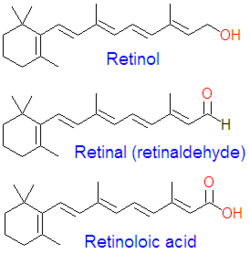Vitamin A: Difference between revisions
imported>David E. Volk m (New page: {{subpages}} {{Image|Retinol and related.png|right|350px|Retinol (Vitamin A) and related compounds.}} '''Vitamin A''', or '''retinol''', is the immediate precursor of two important bioche...) |
imported>David E. Volk No edit summary |
||
| (4 intermediate revisions by the same user not shown) | |||
| Line 1: | Line 1: | ||
{{subpages}} | {{subpages}} | ||
{{Image|Retinol and related.png|right| | {{Image|Retinol and related.png|right|250px|Retinol (Vitamin A) and related compounds.}} | ||
'''Vitamin A''', or '''retinol''', is the immediate precursor of two important biochemicals, [[retinal]] and [[retinoic acid]]. Ultimately, retinol is derived biochemically from [[carotene]]s such as<math>\beta</math>-[[carotene]], but is not derived from similar [[carotenoid]]s such as [[lutein]] or [[zeaxanthin]]. Retinal plays a critical role in [[vision]], while retinoic acid is an intracellular messenger chemical that affects [[gene]] [[transcription]]. Although plants do not produce retinol, they do produce carotenes which can be converted to retinol in the gastrointestinal tract. | '''Vitamin A''', or '''retinol''', is the immediate precursor of two important biochemicals, [[retinal]] and [[retinoic acid]]. Ultimately, retinol is derived biochemically from [[carotene]]s such as<math>\beta</math>-[[carotene]], but is not derived from similar [[carotenoid]]s such as [[lutein]] or [[zeaxanthin]]. Retinal plays a critical role in [[vision]], while retinoic acid is an intracellular messenger chemical that affects [[gene]] [[transcription]]. Although plants do not produce retinol, they do produce carotenes which can be converted to retinol in the gastrointestinal tract. | ||
{{Image|Beta-carotene.png| | == Physiological Effects == | ||
Deficiencies of vitamin A has been associated with a number of maladies related to<ref>{{cite web | title = Vitamin A (Retinol) at Colorado State | url = http://www.vivo.colostate.edu/hbooks/pathphys/misc_topics/vitamina.html | accession = 20091027}}</ref>: | |||
*'''Vision''': Retinal is a critical structural component of [[rhodopsin]], the light sensitive (purple vision) pigment within rod and cone cells of the retina. | |||
*'''Infections''': Vitamin A has an anti-infective effect. | |||
*'''Skin''': Epithelial cells require vitamin A for differentiation and maintenance - lack of vitamin A leads to keratinized and scaly skin, due to impaired gene transcription due to insufficient retinoic acid. | |||
*'''Reproduction''': Vitamin A is essentially for the production of sperm and normal female reproductive cycles. | |||
== Biosynthesis == | |||
{{Image|Beta-carotene.png|right|500px|<math>\beta</math>-carotene.}} | |||
Retinol is synthesized from <math>\beta</math>-carotene biologically by a [[dioxygenase]] mechanism in which the 15 & 15' carbons are dioxygenated by molecular oxygen with carbon-carbon bond cleavage. In experiments using tritium (H<sup>3</sup>) and carbon-14 (C<sup>14</sup>) labels, no loss of the labels occurs during the conversion of carotene into two molecules of retinol.<ref>{{cite journal | journal = Journal of Biological Chemistry | authors = Goodman, DS, Huang, HS and Shiratori, T | title = Mechanism of the Biosynthesis of Vitamin A from β-Carotene | volume = 241 | pages = 1929-1932 | year = 1966}}</ref> | |||
== References == | |||
<references/> | |||
Latest revision as of 15:06, 28 October 2009
Vitamin A, or retinol, is the immediate precursor of two important biochemicals, retinal and retinoic acid. Ultimately, retinol is derived biochemically from carotenes such as-carotene, but is not derived from similar carotenoids such as lutein or zeaxanthin. Retinal plays a critical role in vision, while retinoic acid is an intracellular messenger chemical that affects gene transcription. Although plants do not produce retinol, they do produce carotenes which can be converted to retinol in the gastrointestinal tract.
Physiological Effects
Deficiencies of vitamin A has been associated with a number of maladies related to[1]:
- Vision: Retinal is a critical structural component of rhodopsin, the light sensitive (purple vision) pigment within rod and cone cells of the retina.
- Infections: Vitamin A has an anti-infective effect.
- Skin: Epithelial cells require vitamin A for differentiation and maintenance - lack of vitamin A leads to keratinized and scaly skin, due to impaired gene transcription due to insufficient retinoic acid.
- Reproduction: Vitamin A is essentially for the production of sperm and normal female reproductive cycles.
Biosynthesis
Retinol is synthesized from -carotene biologically by a dioxygenase mechanism in which the 15 & 15' carbons are dioxygenated by molecular oxygen with carbon-carbon bond cleavage. In experiments using tritium (H3) and carbon-14 (C14) labels, no loss of the labels occurs during the conversion of carotene into two molecules of retinol.[2]
References
- ↑ Vitamin A (Retinol) at Colorado State.
- ↑ (1966) "Mechanism of the Biosynthesis of Vitamin A from β-Carotene". Journal of Biological Chemistry 241: 1929-1932.


